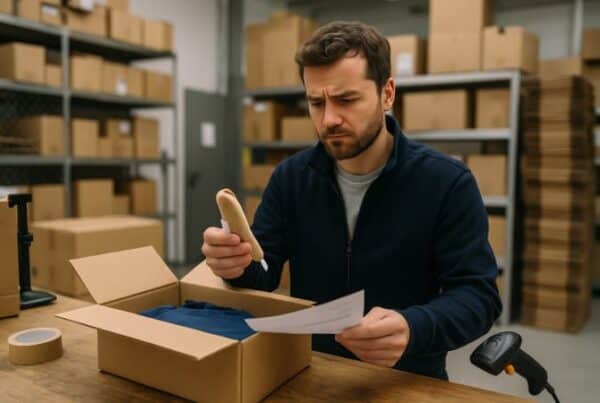Courier issues happen. Whether it’s a lost package, a damaged shipment, or a delayed delivery, claims are part of running an e-commerce business. But when it comes time to actually file a claim with your courier, things can get messy. Different forms, different deadlines, different rules. And if you get it wrong? You could lose the refund entirely.
In this guide, we walk you through the process of filing a courier claim, step by step. So you can recover costs faster, keep your customers happy, and stop wasting time on avoidable mistakes.
What are courier claims and when should you file one?
A courier claim, also called freight claim, is a formal request to a shipping provider or courier for compensation when something goes wrong during transit. That might include:
- A parcel that gets lost in transit
- A shipment that arrives damaged
- A delivery that arrives well past its promised window
- An overcharge on shipping costs
But here’s the thing: many merchants don’t file claims at all. The process feels too complex, time-consuming, or simply not worth the effort. Especially without a clear internal workflow in place. As a result, refunds are left on the table and issues go untracked.
Who can file courier claims — and who can’t
Typically, only the sender (that’s you) can file a claim, since they hold the courier contract. In some cases, the receiver can also initiate a claim with the sender’s permission or support.
- Shippers (senders) are generally the only party who can file a claim directly.
- Receivers may be able to file, but only with the shipper’s approval or with specific courier consent.
- Insured parties can file if their name is listed on the insurance policy, typically the sender.
- For marketplace shipments, the process may involve platform-specific workflows.
When is it worth filing a claim?
| Worth filing if… | Not worth filing if… |
|---|---|
| ✅ Shipment value is significant | ❌ Admin costs outweigh potential refund |
| ✅ You are within the claim deadline | ❌ Deadline has already passed |
| ✅ You have clear evidence and full documentation | ❌ You lack essential documentation (e.g. photos, invoice) |
| ✅ Issue impacts customer experience or revenue | ❌ Damage was caused by improper packaging |
| ✅ You’re eligible as sender or insured party | ❌ Refund amount is minimal and effort isn’t justified |
Even when a claim feels minor, having a structured process in place ensures you don’t leave money on the table.
What you need before filing a courier claim
Before you start the claim process, make sure you have these documents ready:
- Proof of shipment (e.g. tracking number or shipping label)
- Proof of value (e.g. invoice or order confirmation)
- Photo evidence (clear images of the damaged goods and packaging)
- Proof of delivery (POD, if applicable)
- Original packaging, if damage is involved (many courier require this)
- Claim form or link to the courier’s submission portal
💡Tip: Store these documents in one place to speed up your internal process. Especially if you manage multiple claims per week!
How to file courier claims: step by step
Step 1: Detect and document the issue
Train your warehouse or CS team to document every issue immediately. That includes timestamped photos, written notes, and keeping the packaging intact.
Include multiple angles of the damaged item, images of the parcel before and after opening, and a note describing the damage.
Step 2: Check the courier’s deadline
Each courier has its own rules. Miss the deadline, and your claim could be rejected automatically. Here’s a quick overview:
| Courier | Claim type | Deadline | Who can file | Notes |
| Evri | Loss | 28 days from shipment | Shipper | Standard £20 cover unless Full Cover bought. Must not be prohibited item. DOR (delivery confirmation) required if tracking shows delivered. |
| Damage | 28 days from shipment | Shipper | Free £20 damage cover available. Full Cover increases limit. Requires packaging/photos; form must be returned within 14 days. | |
| Delay | 28 days from order | Shipper | Compensates only if >5 days late; refund of postage; no consequential loss. | |
| DPD | Loss / damage | Notify within 14 days of dispatch; evidence within 28 days | Shipper (account holder) | Must provide photos and proof of value; £100 standard cover; claim rejected if submitted late or without evidence. Same applies for DPD Local. |
| Royal Mail | Damage / part-loss | 80 calendar days from posting | Shipper or recipient | Only one payment; excludes cosmetic damage. |
| Loss | 80 calendar days from posting | Shipper | May require waiting period depending on service (7–10 working days). | |
| Delay | Special Delivery: 14 days; Other: 3 months | Shipper | Special Delivery (9am/1pm) must be claimed within 14 days; others within 3 months of posting. | |
| DHL Express | Damage or loss | 30 days from shipment acceptance | Shipper | Must keep packaging/contents for inspection; written claim required within 30 days. |
| Delay (Money Back Guarantee) | 14 days from shipment | Shipper | Applies only to time-guaranteed express services; refund/credit processed in ~30 days. | |
| UPS | Damage | 14 calendar days from delivery | Shipper | Must notify UPS in writing; packaging and item must be kept for inspection. |
| Loss | 60 calendar days from scheduled delivery | Shipper | No claims accepted after 60 days. | |
| Delay | 21 calendar days from delivery | Shipper | Applies only to time-guaranteed services. | |
| FedEx | Loss | Notify within 9 months from shipment | Shipper or recipient | Full documentation must be submitted within same 9-month period. |
| Delay / damage | Notify within 21 calendar days from delivery | Shipper or recipient | Must keep packaging and damaged goods | |
| Parcelforce | Loss | 30 days from dispatch | Shipper | Proof of dispatch and value needed; standard cover £100–£200 depending on service. |
| Damage | 30 days from dispatch | Shipper | Photos, repair estimates needed; must sign as damaged on delivery. | |
| Delay | 30 days from dispatch | Shipper | Partial/full refund for express services only; no consequential coverage. | |
| DHL eCommerce | Damage | 7 calendar days from delivery scan | Shipper (contract holder) | Visible damage must be reported immediately; packaging & contents must be kept. |
| Loss / delay | Typically within 30 calendar days of shipment date | Shipper | Claim should be filed as early as possible; deadlines may vary by service type and contract | |
| Yodel | Loss | 28 days from dispatch | Shipper | Treats as lost after 3+ days no scan; excludes safe place deliveries; £50 standard cover. |
| Damage / part-loss | 14 days from delivery | Shipper | Photos and value proof required. | |
| Amazon Shipping | Damage | 28 days from shipment | Shipper | Must include photos. |
Note: Be sure to check the relevant courier’s latest claim conditions on their site for the most up-to-date information.
Step 3: Complete the claim form
Each courier has a slightly different process. Some offer online portals, others require PDF uploads or emails. Always fill in every required field and double-check your attachments.
Step 4: Submit and track the claim
Once submitted, log the claim date and set a reminder to follow up. Larger couriers may take up to 30 days to respond. Don’t let claims disappear in your inbox!
Common mistakes that lead to denied courier claims
- Rushing or delaying the process: Filing too late or too hastily without all the required details can lead to automatic rejection.
- Poor documentation: Missing invoices, blurry photos, or a lack of tracking proof weakens your claim from the start.
- Incomplete or incorrectly formatted forms: Without standardised procedures, it’s easy to leave out fields, upload the wrong file, or skip a required signature—all of which can delay or invalidate your claim.
- Unstructured tracking and communication: Managing claims via email threads or spreadsheets leads to missed updates, especially when working with multiple couriers.
- No follow-up strategy or assuming the courier will follow up: Most won’t. If you don’t nudge, they may close the claim silently.
- Packaging doesn’t meet courier standards: If the damage was caused (or worsened) by poor packaging, the courier may deny the claim even if everything else is correct.
Tips to improve your claim success rate
💡Use checklists tailored to each courier: Every courier has unique documentation rules. A simple checklist reduces errors and speeds up claim filing.
💡Assign clear roles for documentation and follow-up: Define who documents damage, who submits claims, and who tracks status. A clear process reduces bottlenecks.
💡Set up calendar alerts for deadlines: Use your CRM, support tool, or even shared Google Calendar to alert your team before each claim deadline expires.
💡Keep all documents and templates in a central location: Keep all invoices, photos, and forms in one place—whether that’s a shared folder, internal dashboard, or claims tool.
💡Review failed claims regularly to improve success rate: Rejected claims are goldmines for process improvement. Analyse what went wrong and update your checklists accordingly.
💡Standardise your internal damage reporting: Train your fulfilment or warehouse team to inspect and document returns the moment they arrive. Build this into your operations—not as an afterthought.
How process variation across multiple couriers complicates things
Let’s face it: working with just one courier is rare in modern e-commerce. Most brands ship through multiple providers depending on destination, service level, or customer preference. And while this gives you flexibility, it also introduces one major headache: inconsistency.
- Different deadlines: DPD gives you just 2 working days for visible damage, while GLS allows up to 90 days.
- Different submission processes: Some couriers use web portals. Others ask you to email a form—or worse, print and post it.
- Different documentation standards: DHL might want detailed packaging photos. PostNL may require a specific claim code format.
- Different response times: Some couriers reply within 10 business days. Others go silent for weeks unless you follow up.
Your team ends up juggling five portals, seven claim forms, and more spreadsheets than anyone wants to manage. And that complexity often leads to missed deadlines, lost refunds, and burnt-out support teams.
This patchwork of procedures is hard enough for small teams to manage. As your volume scales, so does the chaos…and the risk of letting valid claims slip through the cracks.
That’s why many growing merchants move toward standardised workflows and automation—so every claim follows a consistent internal process, no matter which courier caused the issue.
How Support Automation simplifies the process
This is where tools like Support Automation step in.
Sendcloud’s Support Automation helps you:
- Spot delivery issues early
- Generate and send courier claims automatically
- Track every claim by courier and deadline
- Monitor recurring issues and refund trends
Claims get resolved up to 8x faster. Support teams respond 3x faster. And you don’t leave refunds on the table.
Never heard of Support Automation or Delivery Issue Management? Check out our Support Automation Guide!
What’s next: claim less, recover more
Mastering claims is just the beginning. To truly protect your margins and customer trust at scale, go one step further:
- Identify root causes: Are most claims coming from one courier, service type, or region? Dig into your data to stop issues before they start.
- Build claim KPIs: What’s your average recovery time? Which agents close the most claims? Turn claims into a measurable, improvable process.
- Level up your workflows: Map out how claims move through your team. Then optimise handovers, communication, and tools—one friction point at a time.
Want to spend less time chasing couriers and more time growing your brand? Discover Support Automation by Sendcloud.















